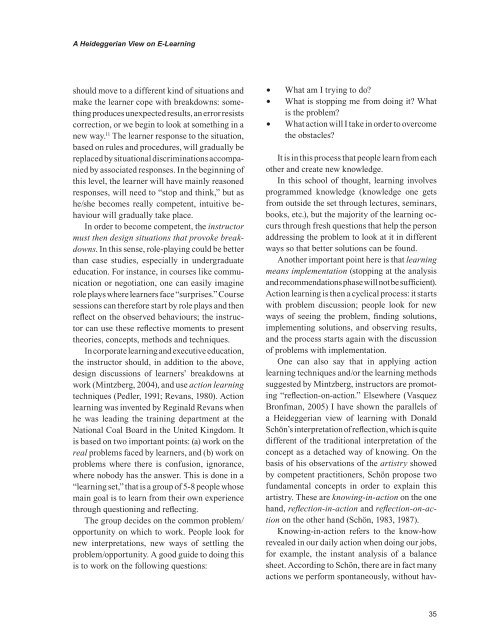Advances in E-learning-Experiences and Methodologies
Create successful ePaper yourself
Turn your PDF publications into a flip-book with our unique Google optimized e-Paper software.
A Heideggerian View on E-Learn<strong>in</strong>g<br />
should move to a different k<strong>in</strong>d of situations <strong>and</strong><br />
make the learner cope with breakdowns: someth<strong>in</strong>g<br />
produces unexpected results, an error resists<br />
correction, or we beg<strong>in</strong> to look at someth<strong>in</strong>g <strong>in</strong> a<br />
new way. 11 The learner response to the situation,<br />
based on rules <strong>and</strong> procedures, will gradually be<br />
replaced by situational discrim<strong>in</strong>ations accompanied<br />
by associated responses. In the beg<strong>in</strong>n<strong>in</strong>g of<br />
this level, the learner will have ma<strong>in</strong>ly reasoned<br />
responses, will need to “stop <strong>and</strong> th<strong>in</strong>k,” but as<br />
he/she becomes really competent, <strong>in</strong>tuitive behaviour<br />
will gradually take place.<br />
In order to become competent, the <strong>in</strong>structor<br />
must then design situations that provoke breakdowns.<br />
In this sense, role-play<strong>in</strong>g could be better<br />
than case studies, especially <strong>in</strong> undergraduate<br />
education. For <strong>in</strong>stance, <strong>in</strong> courses like communication<br />
or negotiation, one can easily imag<strong>in</strong>e<br />
role plays where learners face “surprises.” Course<br />
sessions can therefore start by role plays <strong>and</strong> then<br />
reflect on the observed behaviours; the <strong>in</strong>structor<br />
can use these reflective moments to present<br />
theories, concepts, methods <strong>and</strong> techniques.<br />
In corporate learn<strong>in</strong>g <strong>and</strong> executive education,<br />
the <strong>in</strong>structor should, <strong>in</strong> addition to the above,<br />
design discussions of learners’ breakdowns at<br />
work (M<strong>in</strong>tzberg, 2004), <strong>and</strong> use action learn<strong>in</strong>g<br />
techniques (Pedler, 1991; Revans, 1980). Action<br />
learn<strong>in</strong>g was <strong>in</strong>vented by Reg<strong>in</strong>ald Revans when<br />
he was lead<strong>in</strong>g the tra<strong>in</strong><strong>in</strong>g department at the<br />
National Coal Board <strong>in</strong> the United K<strong>in</strong>gdom. It<br />
is based on two important po<strong>in</strong>ts: (a) work on the<br />
real problems faced by learners, <strong>and</strong> (b) work on<br />
problems where there is confusion, ignorance,<br />
where nobody has the answer. This is done <strong>in</strong> a<br />
“learn<strong>in</strong>g set,” that is a group of 5-8 people whose<br />
ma<strong>in</strong> goal is to learn from their own experience<br />
through question<strong>in</strong>g <strong>and</strong> reflect<strong>in</strong>g.<br />
The group decides on the common problem/<br />
opportunity on which to work. People look for<br />
new <strong>in</strong>terpretations, new ways of settl<strong>in</strong>g the<br />
problem/opportunity. A good guide to do<strong>in</strong>g this<br />
is to work on the follow<strong>in</strong>g questions:<br />
• What am I try<strong>in</strong>g to do?<br />
• What is stopp<strong>in</strong>g me from do<strong>in</strong>g it? What<br />
is the problem?<br />
• What action will I take <strong>in</strong> order to overcome<br />
the obstacles?<br />
It is <strong>in</strong> this process that people learn from each<br />
other <strong>and</strong> create new knowledge.<br />
In this school of thought, learn<strong>in</strong>g <strong>in</strong>volves<br />
programmed knowledge (knowledge one gets<br />
from outside the set through lectures, sem<strong>in</strong>ars,<br />
books, etc.), but the majority of the learn<strong>in</strong>g occurs<br />
through fresh questions that help the person<br />
address<strong>in</strong>g the problem to look at it <strong>in</strong> different<br />
ways so that better solutions can be found.<br />
Another important po<strong>in</strong>t here is that learn<strong>in</strong>g<br />
means implementation (stopp<strong>in</strong>g at the analysis<br />
<strong>and</strong> recommendations phase will not be sufficient).<br />
Action learn<strong>in</strong>g is then a cyclical process: it starts<br />
with problem discussion; people look for new<br />
ways of see<strong>in</strong>g the problem, f<strong>in</strong>d<strong>in</strong>g solutions,<br />
implement<strong>in</strong>g solutions, <strong>and</strong> observ<strong>in</strong>g results,<br />
<strong>and</strong> the process starts aga<strong>in</strong> with the discussion<br />
of problems with implementation.<br />
One can also say that <strong>in</strong> apply<strong>in</strong>g action<br />
learn<strong>in</strong>g techniques <strong>and</strong>/or the learn<strong>in</strong>g methods<br />
suggested by M<strong>in</strong>tzberg, <strong>in</strong>structors are promot<strong>in</strong>g<br />
“reflection-on-action.” Elsewhere (Vasquez<br />
Bronfman, 2005) I have shown the parallels of<br />
a Heideggerian view of learn<strong>in</strong>g with Donald<br />
Schön’s <strong>in</strong>terpretation of reflection, which is quite<br />
different of the traditional <strong>in</strong>terpretation of the<br />
concept as a detached way of know<strong>in</strong>g. On the<br />
basis of his observations of the artistry showed<br />
by competent practitioners, Schön propose two<br />
fundamental concepts <strong>in</strong> order to expla<strong>in</strong> this<br />
artistry. These are know<strong>in</strong>g-<strong>in</strong>-action on the one<br />
h<strong>and</strong>, reflection-<strong>in</strong>-action <strong>and</strong> reflection-on-action<br />
on the other h<strong>and</strong> (Schön, 1983, 1987).<br />
Know<strong>in</strong>g-<strong>in</strong>-action refers to the know-how<br />
revealed <strong>in</strong> our daily action when do<strong>in</strong>g our jobs,<br />
for example, the <strong>in</strong>stant analysis of a balance<br />
sheet. Accord<strong>in</strong>g to Schön, there are <strong>in</strong> fact many<br />
actions we perform spontaneously, without hav-


